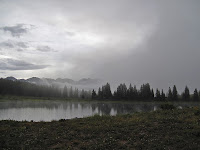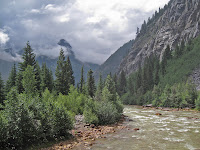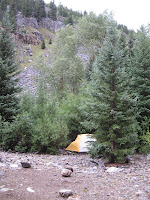 |
| Vestal Peak (left) and Arrow Peak (right) |
As it would turn out, June of 2013 was one of the driest months on record. My hometown of Glenwood Springs, which is located at 5,700 feet and sandwiched in-between the Elk Mountains to the south and the Flat Top Mountains to the north, received precisely zero measurable precipitation during the month, and though the San Juans fared slightly better, hardly anyone could remember so many bluebird days on top of each other. As our luck would have it, a few days before our trip was set to begin, a peculiar, backwards-moving (east to west) low pressure system drew moist, Gulf air directly over the state of Colorado, and our long dry-spell was quickly brought to an end. There were flash floods in Grand Junction, and rain and lightning all-across the state. We knew, watching the forecast as the days of our trip appeared on the extended outlook, what we were likely in for.
DAY 0
So here we are... Today is my birthday. My 30th birthday. And my fiancee, Ella, and I are are camped at Molas Pass awaiting morning so we can begin our backpack trip into the Grenadier Range. It is raining, hard. I get the feeling this is something we will have to get used to.
 |
| Little Molas Lake |
DAY 1
It was foggy this morning, and damn cold. We made breakfast, took down our tent and packed up our bags before 8:30 am. Hardly anything could be seen through the fog as we drove down to the trailhead, wished our car goodbye and got to it.
 |
| Heavy fog and rain ahead... |
The Beaver Ponds are a small series of, well, beaver ponds located at the turn for Vestal Basin. To start our day, we had to descend 1,800 feet from the 10,700-foot Molas Pass trailhead to 8,900 feet at the Animas River, then re-climb 1,000 feet to get here. With the added weight of the climbing gear it had felt horrific near the end.
A moose came strolling into camp earlier.Came up the trail and walked right past us before settling in at the Beaver Pond, where she fed on moss and drank the water for over an hour. At first I was intimidated, being
 |
| The Animas River (8,900') |
We have found a beautiful place here, though some of it has been concealed by this stubborn fog. Who knows what we will be able to see in the coming days. Will we be able to climb Wham? Will it stay socked in with weather? Will there be wildlife and amazing scenery? I am anxious to find out.
DAY 2
After a good, maybe overly long night of sleep, we awoke to another foggy, overcast morning. At first, the dramatic aiguilles of Arrow and Vestal were partially visible through the billowing fog. Soon, however, they vanished once again completely behind a veil of white clouds.
 |
| Arrow Peak (right) and Vestal Peak (left) from camp |
It is hard to say what the weather will be like. Today it is unsettled, though with a seemingly low chance of rain.
After going for a three-mile hike and taking an hour nap, the weather has cleared somewhat and is now about the nicest we have seen. Large patches of blue sky have come to accompany about half the heavens, and it seems possible that, as each day has been minorly better than the last, tomorrow could prove to be a good day for a shot at the summit.
 |
| Arrow Peak coming out of the fog |
Just talked to a group who attempted Wham today and were not able to get very far. As Ella and I have been saying, just being back here has been treat enough to make this trip more than worthwhile, even if the flies are getting bad. Still nothing could compare to the nightmare situation with mosquitoes two years ago in Wyoming.
This evening the rain came back, coming down off and on for several hours. At times it was light enough that we were able to sitting under the protective needles of a tall pine by the lake, hardly feeling even a drop. We watched the rain patterns on the lake surface, and the fog rolling up and down on the hillside. Despite everything being so damp, it was calm and mild.

The storms are coming in from the wrong way. It took me awhile to figure this out but storms have been moving in very slowly from the northeast. They are moving so slowly, however, almost imperceptibly, that it is hard at time to see them move at all. A weather system must be sitting directly over the mountains. Though it means these storms are long, damp and protracted, it also seems that they have no energy and therefore no real lightning. At least, not yet....
DAY 3
Certainly the most interesting day yet. We woke around 5 a.m. after a rather pitiful night's sleep. I couldn't rouse myself for an attempt at Wham. When we awoke fully a few hours later, there was not a cloud in the sky. This made me a bit upset.
To see Arrow and Vestal bathed in sunlight, beckoning with its beautiful, quartzite north face was almost enough to make me want to cry with disappointment. I had wanted to do this climb for so many years and here I was within touching distance and the only thing that kept me off of it was myself.
This severe disappointment was enough to prompt us to pack up and move basecamp up into Vestal Basin for a chance tomorrow. Looking back now from day's end, the jury is still out on whether that was a mistake.
 |
| Ducking logs was the norm en route to Vestal Basin. Hard with a 65-pound pack |
Though the hike was short and gained only about 1,500 vertical feet, it was perhaps the most grueling day of backpacking i have experienced. The "trail" was in bad shape with countless logs to duck under and climb around. With a fully stocked pack, this took a lot of energy. It was steep, loose, overgrown and very frustrating. Of course, we also got off, in one point, on the wrong path and had to battle up a steep scree gully.
Then there was the storm....
Almost immediately upon reaching Vestal Basin, the rain began. We were beat, barely able to carry our packs another foot. We picked a campsite and set-up hastily, noting the evidence that our tentsite had recently had water running through it. We built a levee against the possibility that it would happen again.
The rain/hail/lightning came, our worst storm yet. Some violent lightning for a solid hour, with never more that 10 seconds between rumbles of thunder. It did, however, seem like most of the lightning was cloud-to-cloud. The occasional ground strike really gets your attention when you are at 11,500 feet in a broad meadow with only sparse trees for protection.
 |
| Vestal peak at last, but in the rain.... |
But now the storm has passed and the weather has stabilized. We have realized that the possibility of doing Wham tomorrow is almost impossible. We are simply too low on energy now, too waterlogged, and the weather is too unstable for such a long committing climb. It just seems like it wasnt the right week for an attempt. To matters less appealing, we have a long hike out capped by an 1,800 foot slog out at the very end. At least, I try to convince myself, that part of the trail wont be as unstable as what we did today.
Backpacking is rugged, that is the bottom line. Especially with a full, alpine rack weighing you down from the dark depths of your pack. Type two fun for the vast majority of the time.But it is always good for the soul, and later the pack seems less heavy and the rain storms less soggy when time softens the memories. There is no doubt, however, that at times backpacking is trying and even scary on occasion. Those moments help me appreciate the comforts of home. Maybe in some ways that is the main reason why we come here.
Despite the hardships, this is one hell of a place. One of the most spectacular basins I have visited in Colorado, really. We are at the very toe of Arrow Peak, and earlier had a perfect view of Wham. While it seems that we wont get to climb, those views alone were worth the trip.
DAY 4
 |
| Ella has some fun with Wham |
Next it was time to head down Hell Hill, which earned its moniker today even more than yesterday. Not far into the hike, I sat down to wait for Ella, who I'd gotten ahead of while she was taking pictures of flowers in a field by the creek just behind me. After about fifteen minutes I started getting impatient, whistling and calling out.Frustrated now, I shrugged off my pack and stomped back to look for her. But she had vanished.
Panic ensued. For the next half an hour at least I was running back and forth up and down the trail yelling her name. I couldn't fathom what had happened. After running back and forth three times, the third time going almost all the way back to the turn for camp, I was thoroughly exhausted and decided the only possibility was that she had somehow gotten ahead of me. But how could she get off on the wrong trail like that?
Putting my pack on, I started down the trail only to realize that it was me who had gotten off trail. A little dead end spur, the real trail switchbacking higher up the hill and an almost imperceptibly junction. I was once again fooled by the un-maintained trail.
 |
| Wham Ridge in rare sun |
My ankle was hurting now, after the second even-more-gnarly battle with Hell Hill, and I had to shift my stride to keep from further aggravating it. I took an ibuprofen, something I almost never do, to ease the journey.
The weather was still mostly nice when we reached the Animas. Storms were rumbling over the basin we had left but the low valley was sunny and hot. We spread out all of our clothes and tarps and rain gear to dry for the first time in days.
 |
| Animas camp last night |
"We should move," I said to Ella. "We will just get soaked out here and who knows how long it is going to last. Ella agreed and we started heading back to the tent. That was when it started really coming down. None of the "T word," but just hard, slamming rain. By the time we got back to the tent we were drenched and muddy. To make matters worse, the bottom of the tent had flooded once again.
After using the vestibule to attempt to separate what was dry with what was muddy, we used an old t-shirt to dry off the floor as much as possible. Now we were soaked again, almost everything we had was completely drenched. And the rain came down, pinning us inside that tiny, bright-yellow "shelter." We played a game of travel chess, which ended in a tie as the storm built around us. The lightning started after about a half hour. Spread out but all close ground strikes within five seconds, flash-to-bang (i.e. less than one mile).
 |
| Footbridge over the Animas River |
So now I sit here beside the murky Animas, a river I have long dreamed of kayaking I might add as an aside, writing as night closes in. Tomorrow we will make the long hike out. I am both glad, as rain and thunder and a 70-pound pack have begun to take their toll, but also a bit sad.
For now I will make the most of what we have left. Tomorrow we might be out of the wild but we will still be on vacation. We have earned a few indulgences!
DAY 5
We have escaped. An escape is what it feel like indeed. Battered, tired, hungry, limping, we stumbled out of the Weminuche humbled by our experience. We woke up in the morning to nice weather. We took down camp with some extra excitement, knowing that we were going to get to sleep in a bed and eat a big meal today.
 |
| The Animas crossing on Day 5 |
It seemed fitting to end the trip this way. Maybe our adventure wasn't quite over.
Luckily, we were able to flag down a group from Virginia off the highway who, after myriad advice about car maintenance, were able to get my engine to turn over and start. We were in Silverton ten minutes later, feeling famished. Out of the wild.
Staying now at a cabin in Durango, there is time to reflect on our trip and why we were unsuccessful in making our summit(s). If there was a failure, it was in not moving our camp from the Beaver Ponds at 9,900 feet and into Vestal Basin at 11,500 feet on day two. It was a hard decision to make, as the basin was sock in with fog and rain for nearly the entire day. Had we moved camp through what turned out to be almost an entire day of rain and lightning we would have been in position to capitalize on the weather window on Thursday (day three) morning. Our decision to try to climb Vestal from the Beaver Ponds was foolhardy, as Hell Hill turned out to be proved quite the challenge. But we abandoned this idea at 5:00 am after hours of rain the night before.
 |
| Mountain pose at the end |
On Friday there was a window and we were in perfect position, but we also knew we had to start making our way out of there, and it was a long journey. Ultimately, the worst storm of the week moved in by 3 pm on Friday.
At least know we know the land, and we will be much more prepared the next time we come here. I have concluded we should do a few things different.
1) Take the train. The $85 would have been worth it, as that first 1,800 foot hill was a major drain on energy and resources. It adds 6.5 miles and a lot of elevation to the journey.
2) Get into Vestal Basin as quick as possible. While the Beaver Ponds were a pleasant place to linger, getting Hell Hill over and behind early in the trip rather than later would have been helpful. A one-day shot from the Beaver Ponds is ambitious at best.
3)Perhaps go in September when the weather is more stable. Even the windows to climb that did exist were short for such a long, committing route.
4)Be better conditioned! My body did not react well to the ultra-heavy pack.
Oh well, we had fun and had a challenging experience. We are out now and already civilization is back to its mundane familiarity. But I am glad not to be cowering in the tent from a storm. I feel good and will leave with my head high. It was overall a positive experience.
For information about how to contact us, visit this link












